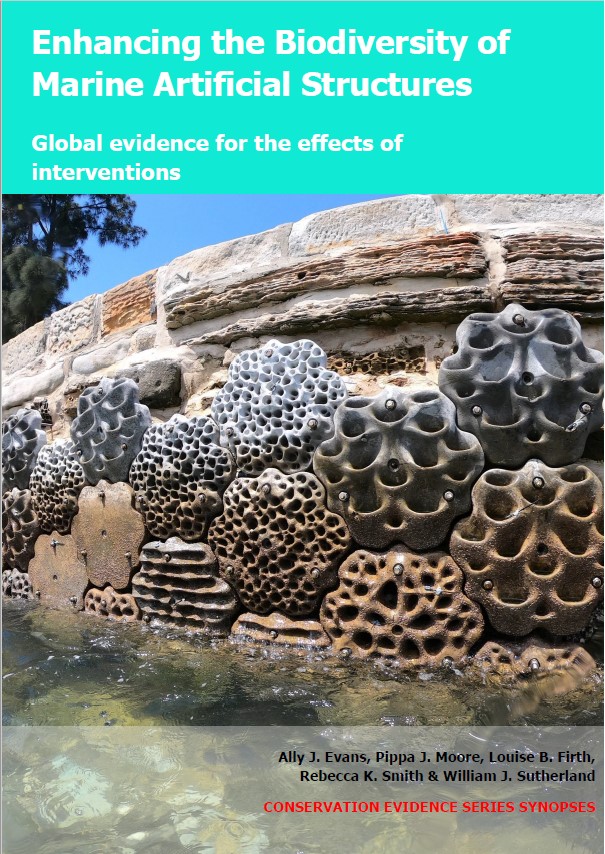Create hole habitats (>50 mm) on subtidal artificial structures
-
Overall effectiveness category Awaiting assessment
-
Number of studies: 3
View assessment score
Hide assessment score
How is the evidence assessed?
-
Effectiveness
not assessed -
Certainty
not assessed -
Harms
not assessed
Study locations
Supporting evidence from individual studies
A replicated, controlled study in 2012–2014 on two subtidal breakwaters on open coastline in the Mediterranean Sea, Israel (Sella & Perkol-Finkel 2015) found that hole habitats created on breakwater blocks, along with pits, grooves and environmentally-sensitive material, supported different macroalgae and invertebrate community composition with higher species diversity than standard-concrete blocks without added habitats, while macroalgae, invertebrate and fish abundances varied depending on the species group. After 24 months, the macroalgae and invertebrate species diversity was higher on blocks with added habitats than without (data reported as Shannon index) and the community composition differed (data reported as statistical model results). Thirty species (7 mobile invertebrates, 14 non-mobile invertebrates, 9 fishes) recorded on and around blocks with added habitats were absent from blocks without. Species abundances varied on blocks with and without added habitats depending on the species group (see paper for results). It is not clear whether these effects were the direct result of creating holes, pits, grooves, or using environmentally-sensitive material. Hole habitats were created on breakwater blocks (1 × 1 × 1 m) using a formliner. Each block had multiple cube-shaped (60 × 60 × 60 mm), cylindrical (diameter: 30 mm; depth: 100 mm) and hemispherical (diameter: 150 mm; depth: 100 mm) holes (T. Hadary pers. comms.) amongst multiple pits and grooves (number/spacing not reported). Five blocks of each of three patented ECOncreteTM materials (lower pH and different cement/additives to standard-concrete) were placed at 5–7 m depth on a concrete-block breakwater during construction in July 2012. Five standard-concrete blocks (1.7 × 1.7 × 1.7 m) without added habitats were placed on a similar breakwater 80 m away. Macroalgae and invertebrates on blocks, and fishes on and around blocks, were counted over 24 months.
Study and other actions testedA replicated, randomized, paired sites, controlled, before-and-after study in 2014–2016 on a subtidal seawall in a marina in the Mediterranean Sea, Israel (Perkol-Finkel et al. 2018) found that hole habitats created on seawall panels, along with grooves, small ledges and environmentally-sensitive material, supported higher macroalgae and invertebrate species diversity and richness and different community composition compared with standard-concrete seawall surfaces without added habitats. After 22 months, macroalgae and invertebrate species diversity (data reported as Shannon index) and richness was higher on panels with added habitats (9 species/quadrat) than on seawall surfaces without (5/quadrat), and compared with seawall surfaces before habitats were added (1/quadrat). Community composition differed between panels with added habitats and seawall surfaces without (data reported as statistical model results). Two non-mobile invertebrate species groups recorded on panels were absent from surfaces without. It is not clear whether these effects were the direct result of creating holes, grooves, ledges, or using environmentally-sensitive material. Hole habitats were created on seawall panels (height: 1.5 m; width: 0.9 m; thickness: 130 mm) using a formliner. Each panel had six cylindrical holes (diameter: 30 mm; depth: 120 mm; ≥300 mm apart) amongst multiple grooves and small ledges. Panels were made from patented ECOncreteTM material. Four panels were attached to a vertical concrete seawall in November 2014. The bottom 1.2 m were subtidal. Panels were compared with standard-concrete seawall surfaces cleared of organisms (height: 1.2 m; width: 0.9 m) adjacent to each panel. Macroalgae and invertebrates were counted in one 300 × 300 mm randomly-placed quadrat on each panel and seawall surface over 22 months.
Study and other actions testedA replicated, controlled study in 2007–2019 on 21 subtidal wave buoy foundations in the North Sea, off the coast of Sweden (Bender et al. 2020) found that creating hole habitats on foundations did not increase the mobile invertebrate and fish species diversity, richness or overall abundance, but did alter their community composition and increase brown crab Cancer pagurus abundances. After 12 years, the mobile invertebrate and fish species diversity (data reported as Shannon and Evenness indices), richness and abundance were similar on and around foundations with holes (10 species/foundation, 51 individuals/foundation) and those without (9 species/foundation, 33 individuals/foundation). The community composition, however, differed (data reported as statistical model results). Three mobile invertebrate species recorded on and around foundations with holes were absent from those without. Brown crabs were more abundant on and around foundations with holes (11/foundation) than without (4/foundation), while the abundances of 47 other fish and mobile invertebrates were similar for both (see paper for results). Hole habitats were created in April 2007 by drilling into the vertical sides of concrete foundations (diameter: 3 m; height: 1 m). There were 26 evenly-spaced cuboidal holes/foundation (width: 120 mm; height: 150 mm; depth: 300 mm): 13 at seabed level and 13 at 0.5 m above the seabed. Eleven foundations with holes and 10 without were placed on sandy seabed at 25 m depth. Fishes and mobile invertebrates were counted on and around (<1 m radius) foundations over 12 years. Holes at seabed level had been buried by sediment and no longer provided habitats.
Study and other actions tested
Where has this evidence come from?
List of journals searched by synopsis
All the journals searched for all synopses
This Action forms part of the Action Synopsis:
Biodiversity of Marine Artificial Structures
Biodiversity of Marine Artificial Structures - Published 2021
Enhancing biodiversity of marine artificial structures synopsis





)_2023.JPG)














